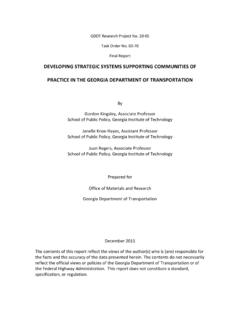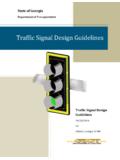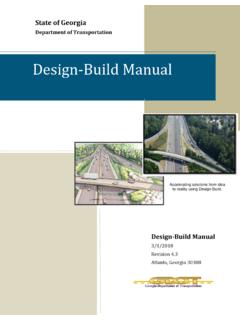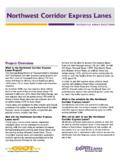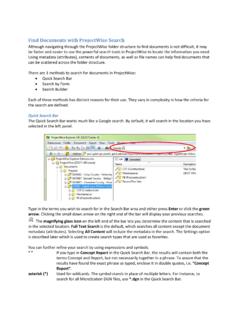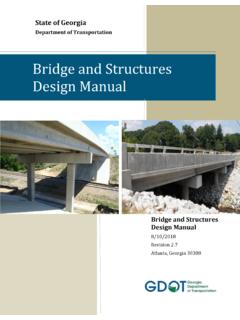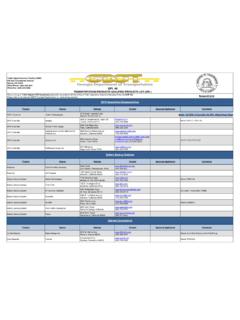Transcription of Guidelines for Lime Stabilization
1 Revised 3/07/11 Guidelines FOR LIME Stabilization I. Why Use Lime? Lime Stabilization has the potential to reduce initial construction costs through improved subgrade stability and reductions in pavement structure. Lime can also provide greater long term stability of the pavement structure and lower pavement life-cycle costs through reduced pavement maintenance. Lime is primarily for use on high clay content soils. Lime Stabilization has been used successfully on projects in both south and northwest Georgia to improve very poor subgrade soils, increase the soil support value and eli minate wasting bad soils.
2 Refer to the following pages for more information on selecting and using lime on projects. If the majority of the soils on a project are IIIC and/or poor quality IIB4 soils in both cuts and fills, lime Stabilization may be considered for use. If the soils are very micaceous, however, do not use lime, as it does not react well with micaceous soils. Use cement Stabilization for micaceous soils. Research shows that 6% cement mixed 9 inches deep is the optimum combination for economics and strength for stabilizing micaceous soils.
3 Whenever the majority of the soils on a proj ect have the following test results, consider using lime Stabilization : Plasticity Index > 15-18 Volume Change > 20-30% Clay Content > 25-30% When dealing with these type soils, always recommend lime Stabilization to the outside edges of the shoulders. When lime Stabilization is recommended, the soil support value (SSV) may be raised to or Remember to state in the soil survey report that the SSV is based on using lime Stabilization . Also consider the higher SSV when making your recommendation for the depth of GAB on Piedmont projects.
4 II. Is Lime Right for My Project? If you are evaluating a project for lime Stabilization , several things must be considered to ensure that lime Stabilization is feasible for the project. Soil conditions are a primary factor in determining whether lime Stabilization is appropriate. However, there may be conditions where the soils are well suited to lime Stabilization but cost and constructability issues may make lime not feasible to use. Also, because lime is recognized as havi ng some potential health and safety issues, it is important that appropriate measures be taken to ensure that these concerns are addressed during construction especially if the project is in an urban area.
5 Consider the following factors when evaluating the constructability of lime on your project: 1. Project Length When determining whether to use lime, consider the length and width of the project. It must be long enough and wide enough to accommodate tanker trucks, motorgraders, harrows, mixers and compacting and finishing equipment. 2. Variable Alignment If the alignment will be shifting frequently, , narrow width construction (10 feet to wedges), lime is typically not recommended for this type construction due to the required safe-ing of the drop-offs adjacent to travel lanes.
6 Using a soil support value representing the untreated soil along with a minimum of 8 to 12 inches of GAB (8 to 10 inches for state routes and urban business areas and 12 inches for interstates) plus an additional 4 inches of GAB for problems areas would be more appropriate here. 3. Widening symmetrically from 2 lanes to 4-5 lanes (with or without curb and gutter) Lime stabilized subgrade can be successfully constructed with this configuration unless the project is in a heavily business laden area which requires frequent and immediate access to businesses.
7 If there are a significant number of businesses, GAB construction may have to be recommended instead of lime. 4. New Construction (2-lane, 4-lane or addition of 2 new lanes) This is the best scenario for lime stabilized subgrade as far as alignment is concerned because there are minimal to no traffic concerns. 5. Rock Projects located along the Fall Line and north of the Fall Line should be evaluated for the presence of rock that could be expected at grade, especially in the Ridge and Valley Region.
8 The materials here are typically plastic cherty clays or shaley clays that normally would be well suited for lime Stabilization , but there are also chert boulders, rock fragments and rock layers in this region, and this has the potential to cause severe wearing of the mixing equipment during the lime operations. If large quantities of rock are present, include a statement in the lime section of the soil survey report that the contractor should be aware of this condition. Look at the boring logs in the cuts and get an idea of how much rock is on the project, how much is above grade, how deep are the fills and where the rock is likely to end up at grade.
9 III. How Much Lime is Needed? The range of lime to use is normally 4 to 6 percent and is based on the soil types on the project- the worse the soils, the higher percentage of lime should be us ed. Stabilization should be a minimum of 6 inches deep for marginal soils (near the lower to mid range of the test results listed above); 8 to 9 inches for poorer soils and 10 to 12 inches for the very worst soils. If there is little experience in dealing with lime, the proper way to determine the optimum amount of lime is to do CBR testing with raw soil using 4, 5 and 6% lime.
10 When calculating lime quantities, the designers must consider the type of application. For hydrated lime, the amount to use is based on the dry weight of the soil. For quicklime, you must use the formula in Section 225 to get the correct amount. Since quicklime contains no water, the amount of lime required is slightly less than that of hydrated lime (see formula in Section 225 Specification). IV. Are There Any Weather Limitations? When using hydrated lime, the time frame in Section 225 should be strictly adhered to (usually April to November) because lime Stabilization needs a sufficient amount of heat to react.
